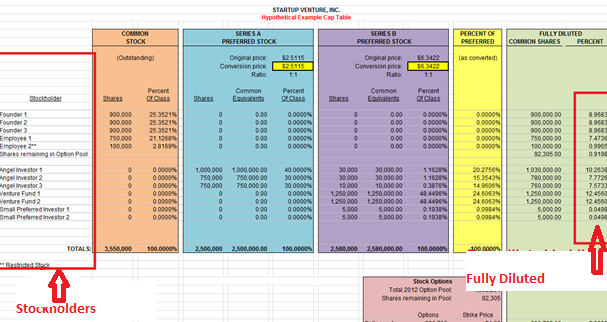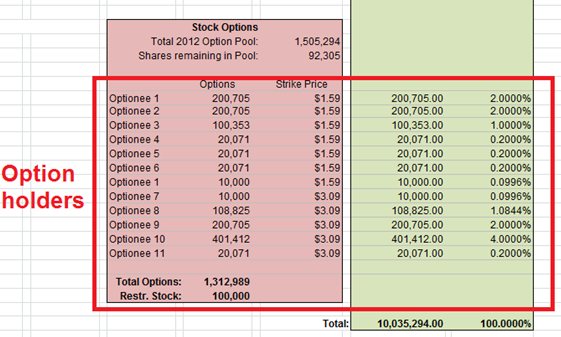
Overview of Cap Tables
1. Introduction to Capitalization
A company's "capitalization" is, in one sense of the word, a breakdown of its ownership structure, in terms of equity and convertible debt. A new venture with just one founder, and no other parties involved yet, has the simplest capitalization possible: the founder holds 100% of the venture's issued and outstanding equity. If the company were sold, the founder would receive 100% of the proceeds following the satisfaction of outstanding liabilities.
Keeping close track of a company's capitalization is crucial, especially as it becomes more complicated. The capitalization informs, among other things, the votes necessary for various thresholds when making certain corporate decisions, who gets paid what amounts in the event the company is sold or liquidated, and the pre-money price of new securities the company might offer in future fundraising rounds.
Complications in a company's capitalization can arise quickly. Thus, the breakdown of the capitalization is generally kept in a table, known as the "cap table." This shouldn't be confused with a stock ledger, which is a similar but much simpler record of the company. A stock ledger essentially is a historical list of all stock certificates, showing when and to whom they were issued and cancellation history. A cap table, on the other hand, shows the relationships among the various equity holders and the company ownership as a whole.
2. General Structure of a Cap Table
A cap table should be kept as simple as possible—easier said than done as the company's capitalization grows. A cap table should be maintained in a spreadsheet program that many people are familiar with (the easiest solution being Microsoft Excel), but there isn't a definitive right way to structure it. A company with multiple classes of stock and convertible debt would use a different structure than a limited liability company with only one membership class, for example.
An example cap table (in Excel format) for a relatively simple startup is available for download at the end of this post. The example company has (1) three founders and two initial employees who hold common stock (with one employee's common stock being restricted stock); (2) three angel investors who invested in a Series A round (likely through convertible notes); (3) four new investors who invested in a Series B round (along with the angel investors); and (4) an option pool equal to 15% of the fully diluted equity of the company, which is nearly depleted due to the outstanding options listed on the cap table.
One typical feature is a complete listing of every holder of the company's equity down the left side of the cap table, and multiple columns listing each class of equity security issued by the company. The spreadsheet program can calculate the percentage of each class held by each holder, and if the securities are convertible, it could also calculate the total amount held by the holder on a fully diluted basis . This is important not only for showing the stockholders' positions relative to each other, but for showing what required votes would look like for stockholder actions if class votes or supermajority requirements are involved.
An additional column could be added for any class of securities that has had an adjustment to its conversion ratio, showing the additional common shares that such holders would receive upon conversion of their preferred as a result of an anti-dilution adjustment. In the example cap table, changing the conversion price in the yellow blocks (based on the calculation set forth in the charter), will update the number of equivalent common shares.
If there's an option pool, it should be reflected on the table as well, and at least broken out into options issued and shares reserved but unallocated. Depending on the size of the company, it may make sense to list each optionholder out separately, if not on the cap table itself, then on another worksheet that updates the cap table (which can help centralize and coordinate option record keeping). Outstanding warrants need to be included, as do outstanding promissory notes that can convert into stock (though this is more complicated if, as is usually the case, it is unclear what the notes will convert into or at what price).
3. Maintaining and Updating a Cap Table
A cap table is a snapshot in time, but it cannot be a static document. The table must be updated every time a change of any sort is made to the company's capitalization. While this obviously occurs from issuances and repurchases of equity by the company itself, changes also arise from transactions between stockholders, issuing convertible debt, or even making changes to the company's incentive option pool or plan. Because a company's capitalization impacts its valuation and decision making requirements, any change must be quickly and accurately documented.
Additionally, a complete and accurate cap table is an invaluable tool when contemplating a fundraising round of some sort. Hypothetical cap tables (generally referred to as "pro forma cap tables") can then be prepared based on the current cap table for fundraising scenarios, showing the range of potential impacts (generally dilution) to current equity holders.
Click here for an example cap table (in Excel format) for a relatively simple startup in a downloadable file.




